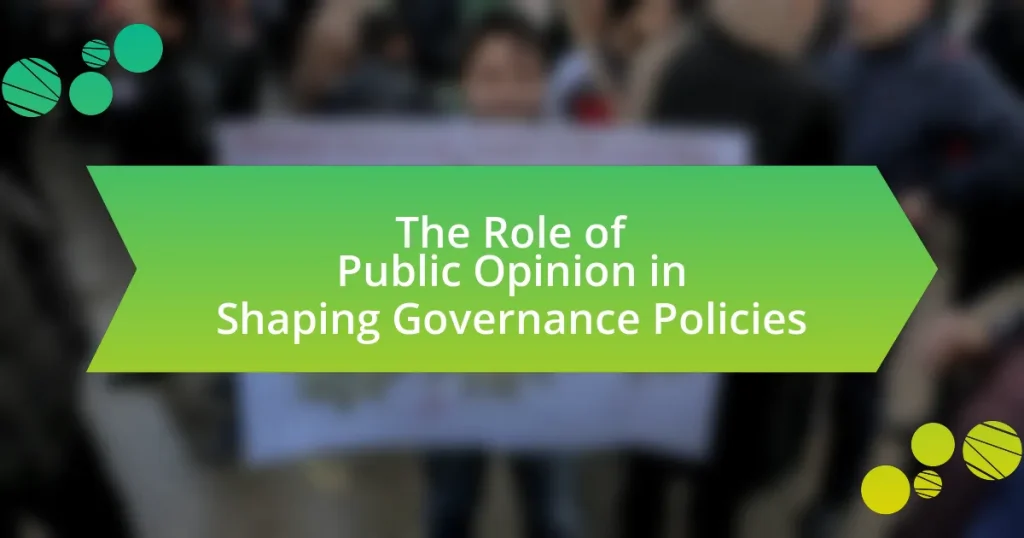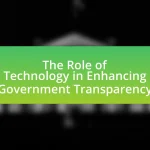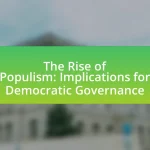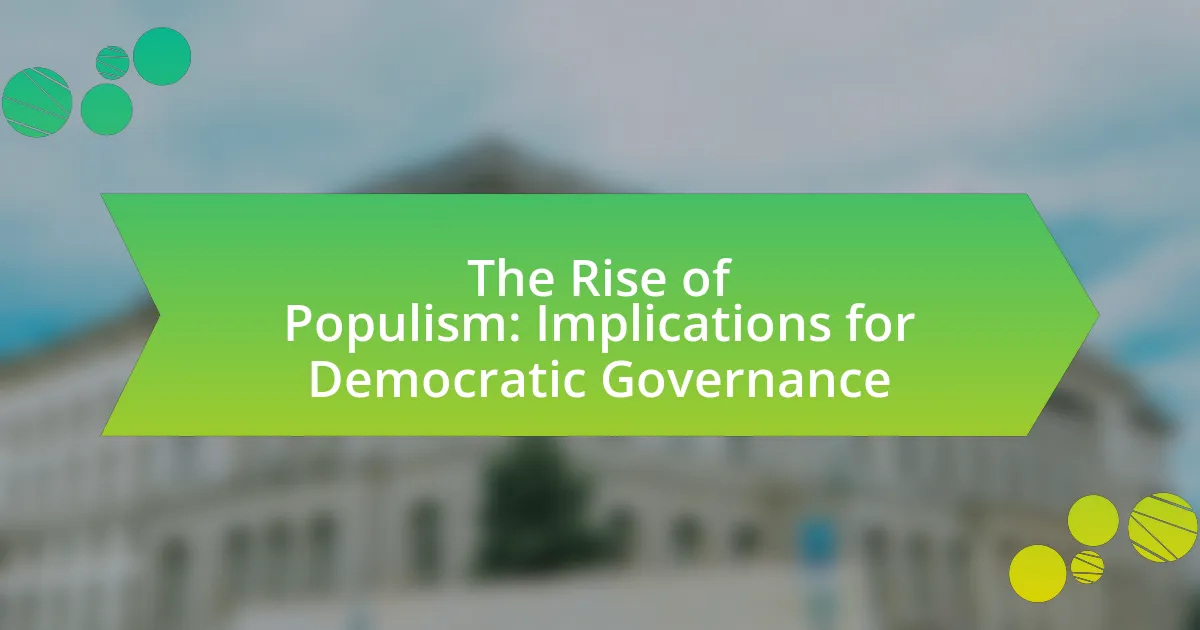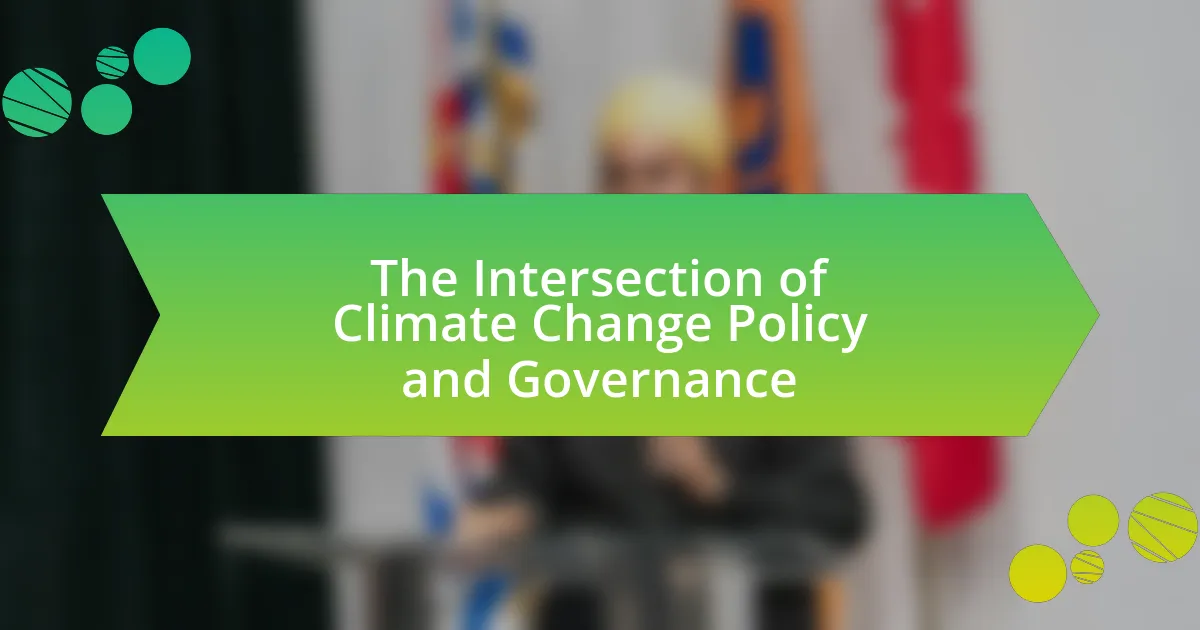Public opinion is a critical factor in shaping governance policies, as it influences decision-makers and legislative agendas. The article explores how public sentiment drives policy changes, illustrated by historical examples and contemporary issues such as healthcare reform and financial regulations. It examines the mechanisms through which public opinion is expressed, including surveys, social media, and public demonstrations, and discusses how policymakers interpret this data to align their actions with constituents’ needs. Additionally, the article highlights the importance of public opinion in democratic governance, accountability, and the factors that affect public attitudes, such as media influence, demographics, and education.
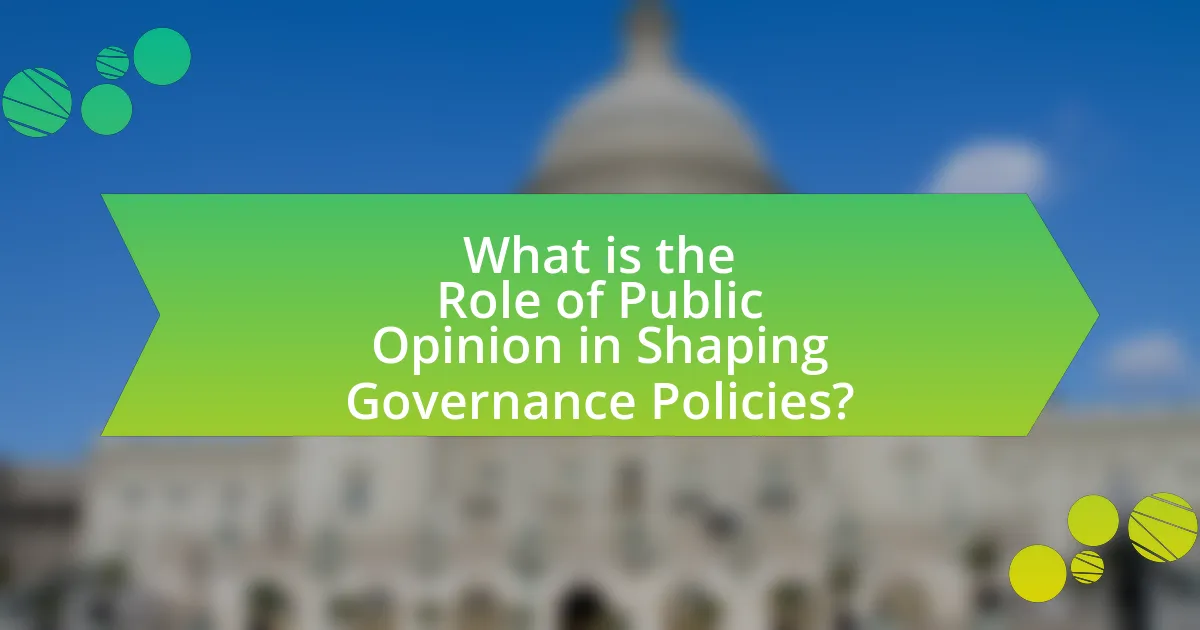
What is the Role of Public Opinion in Shaping Governance Policies?
Public opinion plays a crucial role in shaping governance policies by influencing decision-makers and legislative agendas. When a significant portion of the population expresses a particular viewpoint, elected officials often respond to align with public sentiment to maintain support and legitimacy. For instance, studies have shown that public opinion on issues like healthcare reform or climate change can lead to substantial policy shifts, as seen in the Affordable Care Act’s passage in response to growing public demand for healthcare access. Additionally, surveys and polls serve as tools for policymakers to gauge public priorities, ensuring that governance reflects the electorate’s needs and concerns.
How does public opinion influence decision-making in governance?
Public opinion significantly influences decision-making in governance by shaping the priorities and actions of policymakers. When a majority of the public expresses a particular viewpoint, elected officials often feel compelled to align their policies with these sentiments to maintain support and ensure re-election. For instance, during the 2008 financial crisis, public outrage over bank bailouts led to increased scrutiny and regulatory reforms in the financial sector, demonstrating how public sentiment can drive legislative change. Additionally, opinion polls and surveys provide quantitative data that help governments gauge public priorities, further reinforcing the impact of public opinion on governance decisions.
What are the mechanisms through which public opinion is expressed?
Public opinion is expressed through various mechanisms, including surveys, polls, social media, public demonstrations, and traditional media outlets. Surveys and polls quantitatively gauge public sentiment on specific issues, providing data that reflects collective views. Social media platforms facilitate real-time discussions and mobilization, allowing individuals to share opinions widely and engage with others. Public demonstrations serve as a physical manifestation of collective opinion, showcasing the intensity of public sentiment on particular issues. Traditional media outlets, such as newspapers and television, disseminate information and opinions, shaping public discourse and influencing perceptions. These mechanisms collectively contribute to the understanding and representation of public opinion in governance.
How do policymakers interpret public opinion data?
Policymakers interpret public opinion data by analyzing trends and sentiments to gauge the preferences and concerns of constituents. They utilize surveys, polls, and focus groups to collect quantitative and qualitative data, which helps them understand the public’s stance on various issues. For instance, a Pew Research Center study found that 70% of Americans believe that government should do more to solve problems, indicating a strong public demand for active governance. This data informs policymakers’ decisions, guiding them to align their policies with public expectations and enhance their electoral viability.
Why is public opinion considered a vital component of democratic governance?
Public opinion is considered a vital component of democratic governance because it reflects the collective preferences and values of the citizenry, influencing policy decisions and political accountability. In democracies, elected officials rely on public opinion to gauge the needs and desires of their constituents, ensuring that governance aligns with the will of the people. For instance, studies show that public opinion polls can significantly impact legislative outcomes, as seen in the U.S. Congress, where representatives often adjust their positions based on constituents’ views to secure re-election. This responsiveness to public sentiment fosters a government that is more representative and accountable, reinforcing the democratic principle that power derives from the consent of the governed.
What historical examples illustrate the impact of public opinion on governance?
Public opinion has significantly influenced governance throughout history, with notable examples including the American Revolution and the Civil Rights Movement. During the American Revolution, widespread public sentiment against British taxation and governance led to the Declaration of Independence in 1776, demonstrating how collective dissent can drive political change. Similarly, the Civil Rights Movement in the 1960s saw public opinion shift towards supporting racial equality, culminating in landmark legislation such as the Civil Rights Act of 1964, which was largely a response to the demands of activists and the changing views of the American populace. These instances illustrate that public opinion can serve as a powerful catalyst for governmental reform and policy change.
How does public opinion contribute to accountability in government?
Public opinion contributes to accountability in government by influencing policymakers and holding elected officials responsible for their actions. When citizens express their views through polls, protests, or voting, they signal their approval or disapproval of government performance. For instance, a 2020 Gallup poll indicated that 75% of Americans believed that public officials should be held accountable for their actions, demonstrating the public’s demand for transparency and responsibility. This pressure can lead to changes in policy, the resignation of officials, or the election of new representatives, thereby reinforcing the principle of accountability in governance.
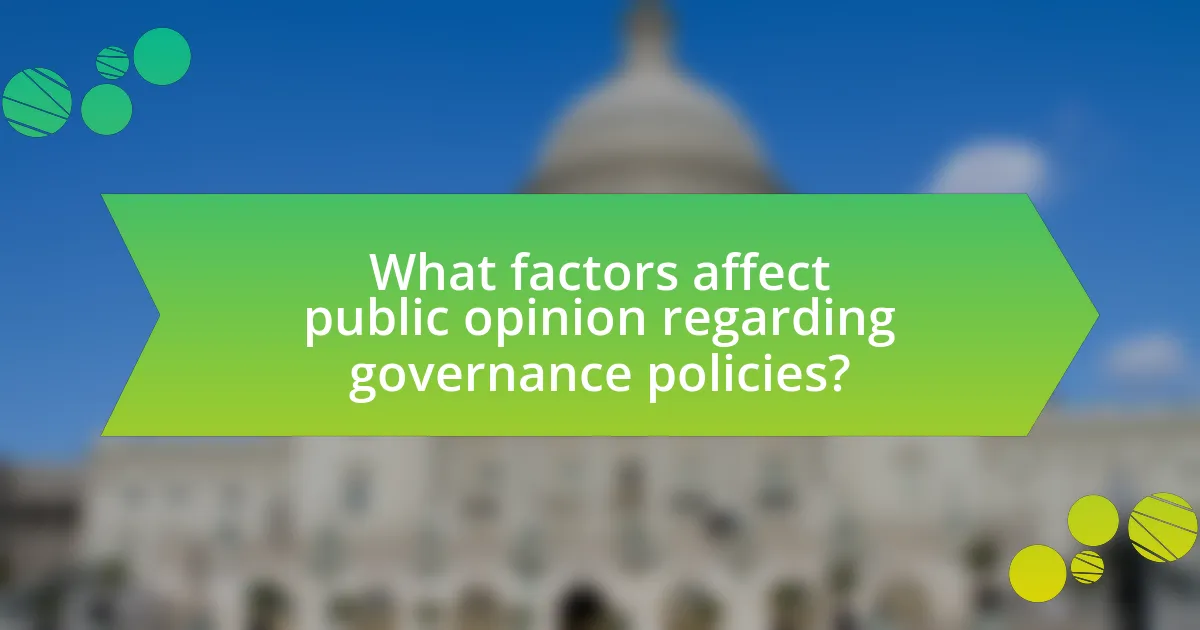
What factors affect public opinion regarding governance policies?
Public opinion regarding governance policies is primarily affected by factors such as media influence, socioeconomic status, education level, political ideology, and personal experiences. Media plays a crucial role in shaping perceptions by framing issues and providing information that can sway public sentiment. For instance, studies show that individuals exposed to biased news coverage are more likely to adopt similar views. Socioeconomic status influences access to information and resources, affecting how individuals perceive and engage with governance policies. Education level correlates with critical thinking skills, enabling individuals to analyze policies more effectively. Political ideology shapes individuals’ values and beliefs, guiding their opinions on governance. Lastly, personal experiences, such as interactions with government services, can significantly impact perceptions of policy effectiveness. These factors collectively contribute to the dynamic nature of public opinion in governance contexts.
How do media and communication channels shape public opinion?
Media and communication channels shape public opinion by influencing perceptions, attitudes, and behaviors through the dissemination of information. Various studies indicate that the framing of news stories, the selection of topics, and the portrayal of issues can significantly affect how individuals understand and interpret events. For instance, research by the Pew Research Center shows that 62% of Americans get their news from social media, which can create echo chambers that reinforce existing beliefs. Additionally, agenda-setting theory posits that media prioritization of certain issues leads the public to perceive those issues as more important, thereby shaping public discourse and opinion.
What role do social media platforms play in influencing public sentiment?
Social media platforms significantly influence public sentiment by facilitating the rapid dissemination of information and enabling user engagement. These platforms allow individuals to share opinions, experiences, and reactions, which can shape collective attitudes and perceptions. For instance, a study by Pew Research Center found that 64% of Americans believe social media has a major impact on the way they think about political issues. This influence is further amplified by algorithms that prioritize content based on user interactions, creating echo chambers that reinforce existing beliefs. Consequently, social media serves as a powerful tool in shaping public opinion, which in turn can affect governance policies and political discourse.
How does the framing of issues affect public perception?
The framing of issues significantly influences public perception by shaping how individuals interpret and respond to information. When issues are framed in a particular way, it can highlight certain aspects while downplaying others, leading to biased interpretations. For example, a study by Entman (1993) demonstrated that framing an economic issue as a “crisis” rather than a “challenge” can evoke fear and urgency, prompting public support for more drastic government interventions. This illustrates that the language and context used in framing can alter public attitudes and opinions, ultimately affecting governance policies.
What demographic factors influence public opinion on governance?
Demographic factors that influence public opinion on governance include age, education level, income, race, and geographic location. For instance, younger individuals often prioritize issues like climate change and social justice, while older populations may focus on healthcare and retirement security. Education level significantly impacts political awareness and engagement, with higher education correlating with progressive views on governance. Income disparities lead to differing priorities, where lower-income individuals may advocate for social welfare programs, while higher-income groups might prioritize tax cuts and economic growth. Racial and ethnic backgrounds also shape perspectives, as minority groups often emphasize equity and representation in governance. Geographic location further influences opinions, with urban residents typically supporting more progressive policies compared to rural populations, who may favor traditional values and limited government intervention. These factors collectively shape the diverse landscape of public opinion on governance.
How do age, gender, and socioeconomic status impact opinions on policies?
Age, gender, and socioeconomic status significantly influence opinions on policies. Research indicates that younger individuals tend to support progressive policies, while older demographics often favor conservative approaches, reflecting generational values and experiences. Gender differences also play a crucial role; for instance, women are generally more supportive of social welfare policies compared to men, influenced by differing socialization and life experiences. Socioeconomic status further impacts policy opinions, as individuals from lower-income backgrounds often advocate for policies that address inequality and provide social safety nets, while those from higher socioeconomic strata may prioritize tax cuts and deregulation. Studies, such as the Pew Research Center’s analysis on public opinion, demonstrate these trends, highlighting how demographic factors shape political preferences and policy support.
What role does education play in shaping public attitudes towards governance?
Education plays a crucial role in shaping public attitudes towards governance by enhancing critical thinking and civic awareness among individuals. Higher levels of education correlate with increased political participation and informed decision-making, as educated citizens are more likely to understand complex governance issues and engage in civic activities. Research indicates that individuals with a college education are more likely to vote and participate in political discussions, thereby influencing governance policies. For instance, a study by the Pew Research Center found that 62% of college graduates reported being very interested in politics, compared to only 38% of those with a high school diploma. This demonstrates that education not only informs public opinion but also empowers citizens to hold their governments accountable.

How can public opinion be effectively measured and analyzed?
Public opinion can be effectively measured and analyzed through a combination of quantitative and qualitative research methods, including surveys, focus groups, and social media analysis. Surveys, such as those conducted by Gallup or Pew Research Center, provide statistical data on public attitudes and preferences, allowing for the identification of trends and patterns. Focus groups offer deeper insights into the motivations and reasoning behind public opinions, facilitating a nuanced understanding of complex issues. Additionally, social media analysis leverages big data techniques to gauge real-time public sentiment, capturing a wide array of opinions across diverse demographics. These methods collectively enhance the accuracy and depth of public opinion analysis, enabling policymakers to make informed decisions that reflect the views of the populace.
What methods are commonly used to gauge public opinion?
Surveys and polls are commonly used methods to gauge public opinion. These tools collect data from a sample of individuals to represent the views of a larger population. For instance, Gallup and Pew Research Center frequently conduct national surveys that provide insights into public sentiment on various issues, demonstrating the effectiveness of these methods in capturing trends and shifts in opinion. Additionally, focus groups and social media analysis are increasingly utilized to understand public attitudes, as they offer qualitative insights and real-time feedback on specific topics.
How do surveys and polls contribute to understanding public sentiment?
Surveys and polls are essential tools for gauging public sentiment by systematically collecting data on individuals’ opinions and attitudes. They provide quantitative insights that reflect the views of a larger population, enabling policymakers to understand the prevailing sentiments on various issues. For instance, a Gallup poll conducted in 2021 revealed that 60% of Americans supported stricter gun control laws, illustrating a significant public sentiment that can influence legislative actions. By analyzing trends over time, surveys and polls help identify shifts in public opinion, allowing governments to adapt their policies to better align with the needs and desires of their constituents.
What are the limitations of different public opinion measurement techniques?
Different public opinion measurement techniques have several limitations, including sampling bias, question wording effects, and response bias. Sampling bias occurs when the sample does not accurately represent the population, leading to skewed results; for instance, telephone surveys may exclude individuals without phones, disproportionately affecting certain demographics. Question wording effects can influence responses; leading or ambiguous questions can result in misinterpretation, as shown in studies where slight changes in phrasing led to significantly different answers. Response bias, including social desirability bias, occurs when respondents provide answers they believe are more acceptable rather than their true opinions, which can distort the data collected. These limitations highlight the challenges in accurately capturing public sentiment and the potential for misinforming governance policies based on flawed data.
How can policymakers respond to public opinion in a constructive manner?
Policymakers can respond to public opinion in a constructive manner by actively engaging with constituents through transparent communication and participatory processes. This approach allows policymakers to gather diverse perspectives, ensuring that policies reflect the needs and values of the community. For instance, studies show that when governments implement public consultations or town hall meetings, citizen satisfaction with governance increases, as seen in the 2018 Canadian federal budget consultations, which led to a more inclusive fiscal policy. By prioritizing dialogue and feedback mechanisms, policymakers can build trust and enhance the legitimacy of their decisions, ultimately leading to more effective governance.
What strategies can be employed to engage the public in policy discussions?
To engage the public in policy discussions, strategies such as utilizing social media platforms, organizing community forums, and implementing participatory budgeting can be employed. Social media platforms allow for real-time interaction and feedback, making it easier for citizens to voice their opinions and engage with policymakers. Community forums provide a space for face-to-face dialogue, fostering a sense of community and encouraging diverse perspectives. Participatory budgeting involves citizens in the decision-making process regarding budget allocations, which has been shown to increase public interest and investment in local governance. For instance, cities like Porto Alegre in Brazil have successfully implemented participatory budgeting, resulting in increased civic engagement and improved public services.
How can feedback mechanisms improve governance based on public opinion?
Feedback mechanisms can improve governance by enabling policymakers to align their decisions with public opinion. These mechanisms, such as surveys, public consultations, and social media engagement, facilitate direct communication between citizens and government officials. For instance, a study by the Pew Research Center found that 70% of Americans believe that public input should influence government decisions. By incorporating this feedback, governments can enhance transparency, accountability, and responsiveness, ultimately leading to policies that better reflect the needs and preferences of the populace.
What best practices should be followed when considering public opinion in governance?
Best practices for considering public opinion in governance include actively engaging with citizens, utilizing diverse feedback channels, and ensuring transparency in decision-making processes. Engaging citizens through surveys, town hall meetings, and social media allows for a comprehensive understanding of public sentiment. Utilizing diverse feedback channels, such as online platforms and community forums, ensures that various demographics are represented, which is crucial for inclusive governance. Transparency in decision-making fosters trust and accountability, as evidenced by studies showing that governments that communicate openly about how public input influences policy decisions tend to have higher public satisfaction and compliance rates.
